Chapter 4 Late Middle Ages
The Late Middle Ages was circa AD 1300–1500 or 1250–1500.
States and territories of the Late Middle Ages
[edit | edit source]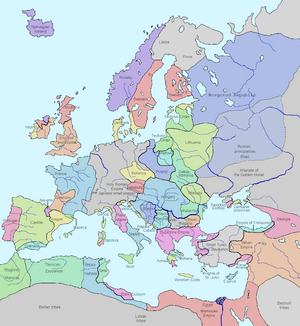

States and territories of the Late Middle Ages included:
- Northern Europe
- British Isles included England and Wales, Ireland, and Scotland. The Kalmar Union (1397–1523) was of the three kingdoms of Denmark, Sweden (then including most of Finland), and Norway. There were also lands of Lapps and Finns.
- Western and Central Europe
- France with Gascony (in southern Aquitaine); Gascony precipitated the Hundred Years' War when it was lost by the English. The Holy Roman Empire was east of France.
- Eastern Europe
- Included Poland (including Mazovia) and Lithuania; Galicia–Volhynia was later divided between Poland and Lithuania. The State of the Teutonic Order (Prussia) and Terra Mariana (of present-day Estonia and Latvia between 1207 and 1561) were Baltic crusader states. Further east: the Kievan Rus' principalities were vassals of the Golden Horde khanate; there was also the Novgorod Republic (1136–1478). Balkans states: included the Kingdom of Hungary, which included the Banate of Bosnia, Croatia, and Transylvania. The Danubian Principalities (Wallachia and Moldavia) were vassals of the Hungarians; after gaining independence they would become vassals of the Ottomans. Further south were the Byzantine Empire, the Second Bulgarian Empire (1185–1396), the Serbian Empire, crusader states (e.g. the Duchy of Athens), and possessions of Venice and Genoa. Louis I of Hungary was was King of Hungary and Croatia from 1342 and King of Poland from 1370; he had many military successes.
- Iberian Peninsula
- Was dominated by Castile, Portugal and Aragon. It also included Navarre, the Kingdom of Majorca (the Balearic Islands), and Islamic Granada. The fall of Granada in 1492 ended the Muslim rule in Iberia.
- Italian Peninsula
- In the north was the Holy Roman Empire; but Italian city-states, such as the Republics of Genoa and Pisa, were starting to assert de facto independence, as well as expanding their territories, including Genoese Corsica. There was also the Papal States and Venice, with Venice greatly expanding its territories along the coasts of the Mediterranean Sea. In the south was the Kingdom of Naples (1282–1816) and Kingdom of Sicily (1130–1816).
Crisis of the Late Middle Ages
[edit | edit source]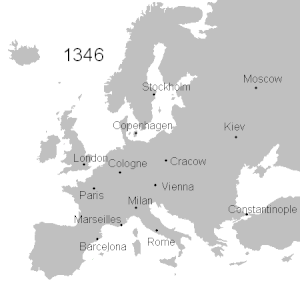
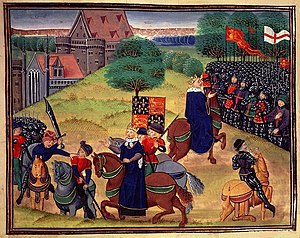
Around 1300, centuries of prosperity and growth in Europe came to a halt, and Europe entered a state of crisis. It resulted in a reduction of the population of Europe by about 50%; but this period was also the beginnings of the Italian Renaissance. Contributors included famines and plagues, revolts, and wars.
Famines and plagues include:
- Great Famine of 1315–1317, mainly due to crop failures. It coincided with the end of the Medieval Warm Period, with some of the worst weather of the Middle Ages. Diseases affecting cattle and sheep also contributed. It ended the period of population growth that had started around 1050.
- Black Death, an outbreak of the plague, peaking 1347 to 1351. It was the second plague pandemic recorded after the Plague of Justinian (542–546). With deaths between 75 and 200 million, it is estimated to have killed between 30% to 60% of Europe's population. Plague is caused by the bacterium Yersinia pestis, and most commonly it results in the bubonic plague with bubos. Bubos are swollen and painful lymph nodes in the area closest to where the bacteria entered the skin, typically from flea bites; they may turn black and necrotic, and burst, and systemic infection can lead to septicemia and pneumonia (septicaemic and pneumonic plagues).
Peasant revolts include:
- Jacquerie (1358, France). It was during the Edwardian phase (1337–1360) of the Hundred Years' War, after the capture of the French king John II. A rise of taxes and breakdown of law and order caused a popular revolt, led by Jacque Bonhomme ("Jack Goodfellow", whose real name was Guillaume Cale). It was suppressed at the Battle of Mello, with severe reprisals enacted against the peasants.
- Peasants' Revolt (England, 1381), Wat Tyler's Rebellion. It was largely a revolt over taxes during the Caroline phase (1369–1389) of the Hundred Years' War. The English King Richard II suppressed the revolt; after Richard met Wat Tyler at Smithfield he was killed by William Walworth, London's mayor.
Wars include (see sections beneath for details):
- Hundred Years' War (1337 to 1453).
- Wars of the Roses (1455–1487).
- Mongol and Tatar raids against Kievan Rus' (1223–1480).
- Wars from the Rise of the Ottomans (1299–1453).
- Burgundian Wars (1474–1477) and War of the Burgundian Succession (1477–1482).
Other wars included the Polish–Teutonic Wars and Wars of Scottish Independence:
- Polish–Teutonic Wars between the Kingdom of Poland and the State of the Teutonic Order. During the 14th, 15th, and early 16th centuries. After the Polish–Teutonic War (1519–1521) the State of the Teutonic Order was secularized as the Duchy of Prussia, and paid homage as a vassal to the Polish king; it entering personal union with Brandenburg in 1611.
- First Wars of Scottish Independence (1296–1328) pitted the English, led by Edward I, Edward II, and Edward III, against the Scots. Sir William Wallace was an iconic figure for the Scots; he defeated the English at the Battle of Stirling Bridge (1297), but was defeated at the Battle of Falkirk (1298), and eventually captured and executed (1305). The English were defeated by Robert the Bruce at the decisive Battle of Bannockburn (1314) which created de facto independence; in the end the English were unsuccessful in their claims to Scotland, confirmed by the Treaty of Edinburgh–Northampton (1328) of Edward III and Robert the Bruce.
- Second Wars of Scottish Independence (1332–1357). Edward Balliol, the son of a former Scottish king, was backed by Edward III of England; he demanded the return of his ancestral lands, and when these were not forthcoming he invaded Scotland and claimed the crown, despite the David II already holding the title. It was another Scottish victory; David II, who had been captured by the English in 1346, was released in 1357, and Edward Balliol surrendered his claim to the throne.
Avignon Papacy and Western Schism
[edit | edit source]
Avignon Papacy (1309–1376): was a period of during which the Popes resided in the Avignon, after manipulation by Philip IV of France. In all seven popes reigned during that period; they were all French, and heavily influenced by the French kings. During this period, the Antipope Nicholas V was crowned in Rome in 1328 at the behest of the Holy Roman Emperor Louis IV (Ludwig the Bavarian).
The Avignon Papacy would eventually lead to the Western Schism (1378–1417) within Roman Catholic Church. Two, even three, men simultaneously claimed to be the true pope, with loyalties divided between them; the non-Roman ones are considered as being antipopes (illegitimate popes). It happened after the death of Gregory XI in 1378, who had moved back to Rome in 1376. Difficulties with the newly elected Pope Urban VI in Rome resulted in the establishment of rival Antipope Clement VII in Avignon, who was succeeded by Antipope Benedict XIII in 1394. There were also rival antipopes in Pisa during the period 1409 to 1415, after the controversial Council of Pisa.
The Western Schism ended with the Council of Constance (1414–1418), held just north of Switzerland. Pope Gregory XII and the Pisa-based Antipope John XXIII stepped down in 1415; and in 1417 Pope Martin V was elected. Avignon-based Antipope Benedict XIII refused to step down and was excommunicated.
Hundred Years' War
[edit | edit source]


Hundred Years' War (1337–1453): was a series of wars in France, primarily between the French and the English. It was triggered by a series of disagreements between the French monarch Philip VI "the Fortunate" (who reigned 1328–1350), and the English House of Plantagenet monarch Edward III (who reigned 1327–1377). This ended in Philip VI confiscating the Duchy of Aquitaine (then essentially corresponding to Gascony) from the Duke of Aquitaine Edward III. Philip VI was the first king of the House of Valois, and succeeded Charles IV "the Fair"; this created a rival claim to the French throne of Edward III through his mother Isabella, the sister of Charles IV. The war can be divided into three phases:
Edwardian War (1337–1360)
[edit | edit source]The English were led by Edward III and his son Edward the Black Prince. With the Battle of Sluys (1340), the English gained command of the seas. The English had a great victory at the Battle of Crécy (1346); and after the Siege of Calais (1346–1347) Calais was held by the English until 1558. The French King Philip VI was succeeded by his son John II (1350), who was captured by the English at the Battle of Poitiers (1356).
With the Treaty of Brétigny (1360), Edward III renounced the French crown, but became Lord of Aquitaine (1360–1362), with Aquitaine as an independent and much enlarged territory than before the war. Conflict was extended between the English and French in the War of the Breton Succession (1341–1365), the Castilian Civil War (1351–1369), and the War of the Two Peters (1356–1375).
Caroline War (1369–1389)
[edit | edit source]When the French King John II died in captivity in 1364, his son, Dauphin Charles, succeeded him as Charles V "the Wise"; he again claimed Aquitaine in 1369 from Edward the Black Prince, the son of Edward III and Prince of Aquitaine (1362–1372). The French had a capable general in Bertrand du Guesclin. The war was mostly characterized by a "Fabian strategy" by the French, avoiding open conflict and concentrating on skirmishes, although there was also a series of battles. At the naval Battle of La Rochelle (1372), the English lost much of their fleet to Castile (who were French allies).
Conflict between the English and French during this period also included Despenser's Crusade (1382–1383), a military expedition led Henry le Despenser (the Bishop of Norwich) to assist the city of Ghent against Louis II of Flanders and the French; and warfare during the 1383–1385 Portuguese interregnum crisis, with the English supporting Portugal and the French supporting Castile.
The French King Charles VI "the Beloved" (the son of Charles V) and the English King Richard II (the son of Edward the Black Prince) would agree the Truce of Leulinghem in 1389, with English-held lands in France much reduced.
Lancastrian War (1415–1453)
[edit | edit source]The English House of Lancaster King Henry V succeeded Henry IV in 1413, and reasserted the claim to the French throne of Edward III. Henry V would have a great victory against the French at the Battle of Agincourt (1415) in Northern France. After the Siege of Rouen (1418–1419), Henry V captured Rouen, the capital of Normandy. In 1420, Henry V and Charles VI signed the Treaty of Troyes, that Henry and his heirs would inherit both kingdoms, and that Henry would marry Catherine of Valois (daughter of Charles VI). Dauphin Charles (the son of Charles VI) was therefore disinherited. Under this treaty, Henry V also formed an alliance with the Burgundians under Philip the Good.
In 1422 Henry V of England and Charles VI of France both died, in August and October respectively. This created rival claimants to the French throne:
- Henry VI, the nine-month-old son of Henry V and Catherine of Valois, who was crowned King of France in 1431.
- Charles VII "the Victorious", the 19-year-old Dauphin of France (heir apparent) and son of Charles VI. Charles VII would eventually be victorious over Henry VI.
At the Siege of Orléans (1428–1429), which was besieged by the English, Joan of Arc rallied the French troops, and the siege was lifted nine day later (8 May 1429). Soon after a series of French victories, including the decisive Battle of Patay (18 June 1429), and the crowning of the Charles VII at Reims Cathedral (17 July 1429), further boosted the French. However Charles the Victorious and Joan of Arc were unsuccessful during the French assault on the English-held Paris (8 September 1429) during the Siege of Paris; and subsequently Joan of Arc was captured by the Burgundians (23 May 1430), and subsequently handed over to the English and executed by burning (30 May 1431).
The resolution of the Armagnac–Burgundian Civil War (1407–1435) gave Charles VII the support of the Burgundians. The French had a major victory at the Battle of Formigny (1450) in Normandy, and the remaining English strongholds in Normandy soon fell. The French victory at the Battle of Castillon (1453) in Gascony was the endpoint of the conflict. All English territories in France were lost by 1453, with the exception of the Pale of Calais.
Burgundian State
[edit | edit source]

The Duke of Burgundy was a powerful figure who ruled the Burgundian State (1384–1482); they were of the House of Valois-Burgundy (1363–1482), the previous dynasty being the House of Burgundy (1032–1361). As well as the French Duchy of Burgundy, they gained control of the Free County of Burgundy, and the Burgundian Netherlands, as well as other lands. The Burgundian Netherlands roughly covered the present-day Low Countries (Belgium, Netherlands and Luxembourg). The Valois dukes and duchesses of Burgundy were the following:
- Philip the Bold (1363–1404). He was given the dukedom by his father John II of France. In 1384 he gained the counties of Artois, Burgundy, Flanders, Nevers, and Rethel, from the inheritance of his wife, Margaret III, Countess of Flanders.
- John the Fearless (1404–1419). In an attempted power grab, John assassinated Louis I, Duke of Orléans, who was the brother of King Charles VI. This resulted in the Armagnac–Burgundian Civil War (1407–1435) between the Burgundians and the Armagnacs (who opposed the Burgundians, named after Bernard VII, Count of Armagnac). This would lead to John's assassination on the Bridge of Montereau; the future King Charles VII was implicated in his death, making the Burgundians enemies with the future king of France.
- Philip the Good (1419–1467). During the Lancastrian War (1415–1453, a phase of the Hundred Years' War), he formed an alliance with the English between 1420 and 1435 with the Treaty of Troyes. Philip's troops captured Joan of Arc in 1430 and later sold her to the English. In 1435, Charles VII of France concluded the Treaty of Arras with Philip, ending the civil war and gaining the support of the Burgundians against the English. This helped France win the Hundred Years' War.
- Charles the Bold (1467–1477). His death ended the Burgundian Wars (1474–1477), a conflict between the Duke of Burgundy and the Old Swiss Confederacy and its allies.
- Mary of Burgundy (1477–1482). Mary had married the Maximilian I, the Habsburg Holy Roman Emperor. The War of the Burgundian Succession (1477–1482) that followed was a war over the partition of the Burgundian lands between Louis XI of France and the House of Habsburg.
After the War of the Burgundian Succession and various treaties, territories including the Duchy of Burgundy would be lost to the French king. But the dukedom would continue with the Free County of Burgundy and the Burgundian Netherlands, passing to the Habsburgs and Habsburg Spain, with Philip the Handsome, who was also King Philip I of Castile.
Philip the Handsome was succeeded as duke by Charles V, Holy Roman Emperor, who was also King Charles I of Spain (Castile and Aragon). Charles V was succeeded by Philip II of Spain, Philip III of Spain, Philip IV of Spain, and Charles II of Spain, the last Habsburg ruler of Spain. After that the dukedom was claimed by the House of Bourbon, before returning to the House of Habsburg, and then to the House of Bourbon again.
War of the Roses
[edit | edit source]
After the reign of English King Richard II (1377–1399), the Plantagenets would divide into two cadet branches; the House of Lancaster and the House of York. The House of Lancaster would rule first, with the reigns of Henry IV; and then his son Henry V; and then his son Henry VI. Henry VI's early reign was overseen by a Regency government (1422–1437). When Henry VI finally became ruler, his ineffective rule and mental instability contributed to the loss of the Hundred Years' War (1453); and in England, a collapse of law and order. Henry VI's wife Margaret of Anjou became the de facto ruler. Henry VI's cousin, Richard of York (the 3rd Duke of York), began to oppose him and his wife's clique.
Wars of the Roses (1455–1487): began when civil war broke out between supporters of the House of Lancaster and the House of York:
- The House of Lancaster, symbolised by the Red Rose of Lancaster, supported the continuing reign of Henry VI.
- The House of York, symbolised by the White Rose of York, supported Richard of York; and after Richard's death in 1460, his son Edward, who would later reign as Edward IV.
After a series of Yorkist victories, Edward IV became king between 1461 and 1470. But in 1469, the Earl of Warwick threw his support behind Henry VI; a series of battles ended with Edward IV fleeing to Flanders in 1470, and the restoration of Henry VI's reign. But at the Battle of Tewkesbury (1471), Henry VI's forces were again defeated by Edward IV, who then returned to London unopposed to resume his reign; with Henry VI, and his son Edward, Prince of Wales, dead.
Edward IV would reign for a further 12 years, before dying in 1483. He was succeeded by his 12-year-old son Edward V, who reigned for 78 days, but was never crowned. Edward V and his brother Richard were kept in the Tower of London, and they were later called the Princes in the Tower. Their fate is uncertain, but they were probably murdered by their uncle, who then reigned as Richard III (1483–1485). Richard III would later be defeated and killed at the Battle of Bosworth Field (1485), by Henry Tudor, who would reign as Henry VII (1485–1509). This ended the Plantagenet dynasty, and began the Tudor dynasty. Henry VII was distantly related to John of Gaunt, Duke of Lancaster, through his mother; and he married Elizabeth of York, the daughter of Edward IV; his emblem, the Tudor rose, combined the red and white roses of Lancaster and York. The War of the Roses ended in 1487 with defeat of the Yorkist rebel John de la Pole, 1st Earl of Lincoln.
Holy Roman Empire and Hanseatic League
[edit | edit source]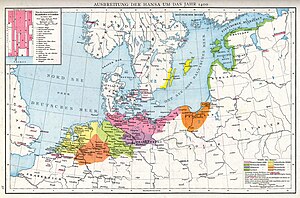
Rulers of states of the Holy Roman Empire around 1300 included the Houses of Wittelsbach, Luxembourg and Habsburg.
- The House of Wittelsbach lands included Bavaria (including the Upper Palatinate), Palatinate, Hainaut, Seeland, Holland and Friesland.
- The House of Luxembourg lands included Luxembourg, Bohemia (including Moravia and Silesia), Brabant and Brandenburg.
- The House of Habsburg lands included Inner Austria (Duchy of Austria, Styria, Carinthia and Carniola), Tyrol and Further Austria (Sundgau and Breisgau).
Hanseatic League (from 1358) was a league of guilds and market towns of Germanic origins, mostly south of the North Sea and Baltic Sea. The Hansa were a trade league, who were also committed to the mutual defense of the members, forming a political-economic alliance. Note that "Hanseatic" is the adjective for the noun Hansa, but also the adjective for hanse (historical for a merchant guild).
They consisted of:
- Hansa Proper: Hanseatic cities in territories divided into quarters. The quarters were the Wendish (Wendish and Pomeranian); Saxon (Saxon, Thuringian and Brandenburg); Baltic (Prussian, Livonian and Swedish); and Westphalian (Rhine-Westphalian and Netherlands, including Flanders).
- Kontore: Hanseatic foreign commercial enclaves, forming the Kontor quarter. Kontore is plural of kontor, literally "branch office". Spread throughout Europe, they were not Hanseatic members, but closely related to Hansa.
- Other ports with Hanseatic trading posts, and cities with a Hanseatic communities.
They would dominate trade in Northern Europe for the next three centuries, before gradually falling apart by the late 17th century. They were an early example of a trade bloc, and these would gradually become to dominate world trade; an example being the European Economic Community of the 20th century, that would become the present-day European Union.
Rise of Muscovy
[edit | edit source]
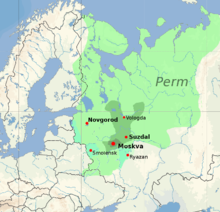
Grand Duchy of Moscow (1283–1547), also known as Muscovy, was a Rus' principality, whose capital was Moscow, and its peoples were termed muscovites. It was a successor state to earlier Rus' states:
- Rostov principality: in the 10th century an eparchy (administrative district) was established in Rostov.
- Principality of Rostov-Suzdal (1125–1157): its capital moved from Rostov to Suzdal in 1125.
- Vladimir-Suzdal (1157–1331), or Grand Duchy of Vladimir; founded by Andrey Bogolyubsky, its capital was the city of Vladimir.
Muscovy's predecessors had been part of Kievan Rus' (882–1240), a loose federation of East Slavic and Finnic people. Kievan Rus' disintegrated during the 12th century, and the Rus' principalities then fell to Mongol invasions in the 1240s, and became vassals of the Golden Horde, a Mongol–Tatar khanate. See Kievan Rus' and the Golden Horde. Their rulers were Mongols, and later on Tatars, with Tatars being a term for the Turkic peoples of the Golden Horde.
Muscovy was the most powerful state to eventually arise after the destruction of Kievan Rus', and subjugation of the Rus' principalities. It began assert influence in the early 14th century, and became the main conduit of reunification and expansion. Its main rival for Rus' dominance was the Novgorod Republic, which prospered from trade in the Hanseatic League particularly in furs. Leading figures included:
- Saint Dmitry Donskoy. He challenged Tatar authority in Russia, and had a great victory against the Tatars at the Battle of Kulikovo (1380) on the Don River. He is venerated as a Saint in the Orthodox Church.
- Ivan the Great (Ivan III Vasilyevich), reigned 1462–1505. He tripled the territory, annexing the Novgorod Republic in 1478, and the Grand Duchy of Tver in 1485, the main rivals to Muscovy. He claimed the title Grand Prince of All Rus'. After marrying Sophia Palaiologina (1472), the niece of the last Byzantine emperor, he claimed Muscovy to be a successor state to the Roman Empire, or the "Third Rome" (the first and second being ancient Rome and Constantinople); and adopted the title of tsar.
- With victory over the Golden Horde at the Great Stand on the Ugra River (1480), he cast off the "Tatar Yoke" and ended their status as a tributary vassal of the Golden Horde.
In 1547 it was followed by the Tsardom of Russia under Ivan the Terrible, and Russia would rise to dominate Eurasia with the Russian Empire.
Between the 13th and 18th centuries, there were numerous battles and skirmishes between the Mongol and Turks and European states, including the Rus' principalities. The Turkic Crimean Khanate, established in 1441, was one of the strongest powers in Eastern Europe until the 18th century. It was eventually conquered by the Russian Empire in 1783; this ended Turkic rule in Europe, except for the Ottoman Empire.
Rise of the Ottoman Empire
[edit | edit source]


Ottoman Empire (1299–1922) and Caliphate (1517–1924): was an empire ruled by Turkish Sunni sultans of the House of Osman; later on they became caliphs (that is, stewards seen as successors to Muhammad). The Ottoman Empire was founded by Osman I (who ruled circa 1299‒1323/4) as an Anatolian Beylik; his father Ertuğrul had ruled the town of Söğüt. The Ottoman Turks were the Turkish-speaking people of the Ottoman Empire. The Grand Vizier, the senior minister of the sultans, became powerful figures with time.
Rise of the Ottoman Empire (1299–1453): was the period from the establishment of the state to the Fall of Constantinople. In the early 14th century Anatolia the declining Seljuk Sultanate of Rum was mostly divided into independent Turkish principalities known as the Anatolian Beyliks. In addition there was also the Greek Byzantines and Empire of Trebizond, the Armenian Kingdom of Cilicia, and the Mongol Ilkhanate to the east. The early conquests included much of Anatolia and the Balkans, eventually gaining the vassal states of the Danubian Principalities (Wallachia and Moldavia). As well other Turks, they fought the Byzantines in the Byzantine–Ottoman wars (1265–1479), as well as Bulgarians, Serbians, Hungarians and Albanians in the Balkans.
Fall of the Byzantine Empire: the Byzantines had been severely weakened during the sacking of Constantinople (1204), the main feature of the Fourth Crusade (1202–1204). Constantinople was finally captured by the Ottoman Turks in 1453 led by Mehmed II the Conqueror, and the Byzantine Empire was soon annexed to the Ottoman Empire. Mehmed expanded the Ottoman Empire particularly over Anatolia and the Balkans. Constantinople began to be known as Istanbul.
A period of growth followed the rise of the Ottoman Empire. It can be divided into the:
- Classical Age (1453–1566)
- Era of Transformation (1566–1703)
At its height In 1683, the Ottoman Empire and its vassals stretched over the Balkans and Anatolia, Levant, western Arabia, Egypt and northern Africa. This was followed by:
- Old Regime (1703–1789)
- Decline & Modernization (1789–1908)
- Dissolution (1908–1922)